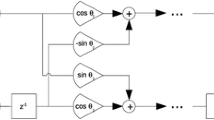Abstract
WMMRmfilters weight the m ordered values in the window with minimum range. If m is not specified, it is assumed to be N + 1 for a window of length 2N + 1. Previous work has demonstrated a subclass of these filters that may be optimized for edge enhancement in that their output converges to the closest perfect edge. In this work it is shown that normalized WMMRmfilters, whose weights sum to unity, are affine equivariant. The concept of the breakpoint of a filter is discussed, and the optimality of median and WMMR filters under the breakpoint concept is demonstrated. The optimality of a WMMRmfilter and of a similar generalized-order-statistic (GOS) filter is demonstrated for various non-L Pcriterion, which we call closeness measures. Fixed-point results similar to those derived by Gallagher and Wise (see N.C. Gallagher and G.L. Wise, IEEE Trans. Acoust., Speech, Signal Process., vol. ASSP-29, 1981, pp. 1136–1141) for the median filter are derived for order-statistic (OS) and WMMR filters with convex weights (weights that sum to anity and are nonnegative), i.e., we completely classify the fixed points under the assumption of a finite-length signal with constant boundaries. These fixed points are shown to be almost always the class of piecewise-constant (PICO) signals. The use of WMMR filters for signal decomposition and filtering based on the Haar basis is discussed. WMMR filters with window width 2N + 1 are shown to be linear over the PICO(N + 1) signals (minimum constant length N+1). Concepts similar to lowpass, highpass, and bandpass for filtering PICO signals are introduced. Application of the filters to 1-dimensional biological data (non-PICO) and images of printed-circuit boards is then demonstrated, as is application to images in general.
Similar content being viewed by others
References
N.C. Gallagher and G.L. Wise, “A theoretical analysis of the properties of the median filter,” IEEE Trans. Acoust., Speech, Signal Process., vol. ASSP- 29, pp. 1136–1141, 1981.
S.G. Tyan, “Median filtering: deterministic properties,” in Two Dimensional Signal Processing: Transforms and Median Filters, T.S. Huang, ed., Springer-Verlag: New York, 1981.
A.C. Bovik, T.S. Huang, and D.C. Munson, “A generalization of median filtering using linear combinations of order statistics, IEEE Trans. Acoust., Speech, Signal Process., vol. ASSP- 31, pp. 1342–1350, 1983.
H.G. Longbotham and A.C. Bovik, “Theory of order statistic filters and their relationship to FIR filters,” IEEE Trans. Acoust., Speech, Signal Process., vol. ASSP- 37, pp. 275–287, 1989.
J.D. Bednar and T.L. Watt, “Alpha-trimmed means and their relationship to median filters,” IEEE Trans. Acoust., Speech, Signal Process., vol. ASSP-32, pp. 145–153, 1984.
P.J. Rousseeuw, “Least median of squares regression,” J. Am. Statist. Assoc., vol. 79, pp. 871–880, 1984.
J.W. Tukey, Exploratory Data Analysis, Addison-Wesley: Reading, MA, 1971.
H. Longbotham and D. Eberly, “The WMMR filters: a class of robust edge enhancers,” IEEE Trans. Acoust., Speech, Signal Process., to be published.
H. Longbotham and N. Barsalou, “A class of optimal generalized order statistic filters that are edge enhancers,” in Nonlinear Image Processing, E.J. Delp. ed., Proc. Soc. Photo-Opt. Instrum. Engl., vol. 1247, 1991.
D. Donoho and P.J. Huber, “The notion of breakdown point,” in A Festschrift for Erich L. Lehman, P.J. Bickel, K. Doksum, and J.L. Hodges, eds., pp. 157–184, Wadsworth: Belmont, CA, 1983.
F.R. Hampel, “The breakdown points of the mean combined with some rejection rules,” Technometrics, vol. 27, pp. 95–107, 1985.
I. Daubechies, “Orthonormal bases of compactly supported wavelets,” Commun. Pure Appl. Math., vol. 41, pp. 909–996, 1988.
P.J. Rousseeuw and A.M. Leroy, Robust Regression and Outlier Detection, John Wiley: New York, 1987.
V.I. Istratescu, Fixed Point Theory, Reidel: Dordrecht, The Netherlands, 1981.
S. Karamardian, Fixed Points: Algorithms and Applications, Academic: San Diego, CA, 1977.
F.F. Bonsall, Lectures on Some Fixed Point Theorems of Functional Analysis, Tata Institute: Bombay, 1962.
S.G. Mallet, “Multifrequency channel decompositions of images and wavelet models,” IEEE Trans. Acoust., Speech, Signal Process., vol. ASSP-37, pp. 2091–2110, 1989.
A.V. Oppenheim and R.S. Schafer, Disrete-Time Signal Processing, Prentice-Hall: New York, 1989.
D. Eberly and H. Longbotham, “Fixed points of order statistic filters,” IEEE Trans. Acoust., Speech, Signal Process., to be published.
C.M. Wang, “A robust estimator for wall following,” Commun, Statist. Theory Methods, vol. 17, pp. 411–422, 1988.
D. Shelton and H.G. Longbotham, “Robust time domain frequency analysis,” in Nonlinear Signal Processing III, J. Astola, C.G. Boncelet, and E.R. Dougherty, eds., Proc. Soc. Photo-Opt. Instrum. Eng., vol. 1658, 1992.
L.A. Glatt, H.G. Longbotham, T.L. Arnow, D.J. Shelton, and P. Ravdin, “An application of WMRR filters to detection and sizing of tumors in mammograms,” in Medical Imaging VI: Image Processing, ed., Proc. Soc. Photo-Opt. Instrum. Eng., vol. 1652, 1992.
B. Dove, D. McDavid, L. Gay, and H.G. Longbotham, “Applications of neural networks for the detection of proximal caries,” J. Dent.Res., vol. 71, p. 241, 1992.
Y.H. Lee and T.F. Adly, “An edge gradient enhacing adaptive order statistic filter”, IEEE Trans. Acoust., Speech, Signal Process., vol. ASSP-35, pp. 680–695, 1987.
Y.H. Lee and T.F. Adly, “A study of convex/concave edges and edge enhancing operators based on the Laplacian,” IEEE Trans. Circuits Syst., vol. 37, pp. 940–946.
H.G. Longbotham, A.C. Bovik, and A.P. Restrepo, “Generalized order statistic filters,” in Proc. IEEE Internat. Conf. on Acoust., Speech, Signal Process., Glasgow, Scotland, 1989.
D. Eberly, H.G. Longbotham, and J. Aragon, “Complete classification of roots to 1-dimensional median and rank-order filters,” IEEE Trans. Acoust., Speech, Signal Process., vol. ASSP-39, 1991.
P.D. Wendt, E.J. Coyle, and N.C. Gallagher, “Stack filers,” IEEE Trans. Acoust., Speech, Signal Process., vol. ASSP-34, pp. 898–911, 1986.
C.M. Wang, “A robust estimator for wall following,” Commun. Statist. Theory Methods, vol. 17, pp. 411–422, 1988.
D. Regan, Evoked Potentials in Psychology, Sensory Physiology and Clinical Medicine, Chapman and Hall: London, 1972.
Author information
Authors and Affiliations
Rights and permissions
About this article
Cite this article
Longbotham, H., Eberly, D. Statistical properties, fixed points, and decomposition with WMMR filters. J Math Imaging Vis 2, 99–116 (1992). https://doi.org/10.1007/BF00118584
Issue Date:
DOI: https://doi.org/10.1007/BF00118584




